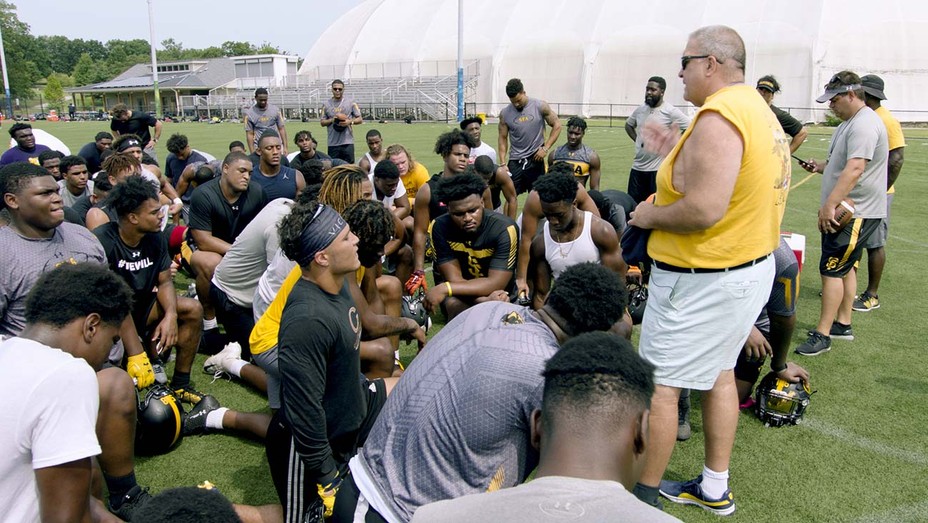
There is a brilliant docuseries to be made about the controversial Panthers high school football program at Baltimore’s St. Frances Academy. Unfortunately, The Cost of Winning isn’t it.
It’s competent enough, perfectly diverting, but it barely skims the surface of the lives of the young men at the school, the complex issues swirling around the program, or the team’s larger-than-life benefactor/coach, Biff Poggi.
I guess the first clue about what kind of show we’re about to see is offered in the credits: “HBO Sports Presents.” Indeed, The Cost of Winning has more in common with a typical sports documentary, a la HBO’s own Hard Knocks, than it does with transcendent works of the genre like Hoop Dreams, The Last Dance, or even STEP, which chronicled the all-girls step team at a Baltimore charter school.
The first episode comes closest to capturing what makes the program so fascinating. Biff Poggi, a colorful, good-ol’-boy type who will remind you of no less than Buddy Garrity from Friday Night Lights, had formerly been the coach at the tony Gilman School. Under his leadership, Gilman was a MIAA (Maryland Interscholastic Athletic Association) powerhouse. The show is vague about why he left, but it seems that he wanted to recruit more aggressively, college-football style, and the school wasn’t having it. So he went to St. Frances, where he already sat on the board.
Here’s the thing about St. Frances: It’s the polar opposite of Gilman. While Gilman has a gleaming campus, manicured lawns, and state-of-the-art facilities, St. Frances doesn’t even have its own field. The kids sometimes have to work out on concrete lots. Their “home games” are at Patterson Park or Morgan State University. The odds were stacked against them.
Until Poggi came along. It’s important to note here that, on top of being a football coach (and a former collegiate offensive lineman, himself), Poggi is also quite rich. He made millions as a hedge fund manager and he generously pours his own money into the St. Frances program. He pays the salaries of the coaches (including former Colt Stan White), he pays the tuition for his players, he even pays for off-campus housing. But why would a local Catholic school need off-campus housing? There’s the rub. While the majority of the kids in the program are recruited from Baltimore, there’s a not insubstantial number who are recruited from all over the country: Florida, Virginia, Pennsylvania, and so on. So St. Frances has become a school where boys with ambitions of playing Division I college football and, ultimately, the pros can come to learn from Poggi and the coaching staff, get free room and board, and showcase their talents on a national stage.
And, with Poggi’s infusion of resources and cash, St. Frances got good. So good that they were whupping the other teams in the MIAA, embarrassing them, and—this is important—severely injuring them, too (not intentionally, of course, but football by its very nature is a brutal sport, and bigger, stronger players can inflict a lot of harm). One by one, the teams in the MIAA, including Gilman, Boy’s Latin, Mount Saint Joseph, and Calvert Hall, forfeited their games against St. Frances, until their football program was forced to exit the league. Now, they play what amounts to a national schedule.
Immediately, there were cries of racism, which is pretty hard to refute. One can only wonder if a program of bruising white boys would’ve been similarly ousted from the league—my hunch is no, but we’ll never know for sure. On the other hand, St. Frances was doing something different from the other teams. It was almost a football trade school. The boys were getting a fine education, sure, but largely in the service of getting into those Division 1 schools they craved. They were bigger and tougher than the other kids. And as concerns about the long-term health hazards of football mount, one can only imagine the pressure the MIAA schools were getting from parents and boards to forfeit those games.
There’s no question where the documentary stands: Squarely on the side of St. Frances (not one of the other MIAA school coaches or administrators are even interviewed). As former Sun sportswriter Milton Kent, now a professor at Morgan State, says, “The other schools had that opportunity [to recruit all over the country], and they didn’t take advantage of it.” I’m not sure that’s completely fair—it seems like Poggi and co. have a different set of criteria for their students. Yes, helping young men, for sure—and the school should be applauded for that (although I couldn’t quite shake the feeling that Poggi was being celebrated as a white savior of sorts). But the real motivation seems to be winning at all costs. As one high school administrator sarcastically told Deadspin: “It just so happens that all the kids who need help happen to be 6-foot-5, 280 pounds, and play football.”
After the first episode lays out the controversy, the three remaining episodes—each, like the first, running just 30 minutes long—have a fairly standard structure. The boys are depicted as scrappy underdogs, proving the haters wrong, and overcoming their hardships. Each episode sets the stakes of a particular big game, which we watch, rooting our Panthers on. We do get to know some of the students: Demon Clowney, a local defensive end who’s had so many friends murdered by street violence, he’s lost count; Blake Corum, a charismatic fullback from Virginia, who some think is too short for the pros; Chris Braswell, the stud linebacker from Baltimore who is considered a can’t-miss NFL prospect; and Alonzo “Ace” Colvin, a local foster kid who can’t seem to get any playing time. With Colvin, a young man who has little chance of playing Division 1 ball, but who is propped by his team, his school, and his loving foster mom, we see St. Frances at its best—truly helping a young man who might’ve otherwise been lost.
But we never dig deep into any of their lives—the whole series is just two hours long, after all. Also, it’s yet another show that depicts Baltimore in the worst possible light. (At one point, mid-huddle during practice, the boys hear gun shots, which barely phases them.) It’s tough. This is the reality of Baltimore, much as it’s hard to face. Still, there’s also something slightly off-putting to me about a show that offers the repeated refrain, “This kid needs to get out of Baltimore”—as though that’s the only path to a productive life. I wish the refrain had been: This kid needs to go to college so he can come back and make Baltimore stronger or be a shining example to others. But The Cost of Winning doesn’t really care about Baltimore. It’s just a generic stand-in for urban blight. Once again, I wish the series had dug deeper.
The Cost of Winning is now streaming on HBO Max.
